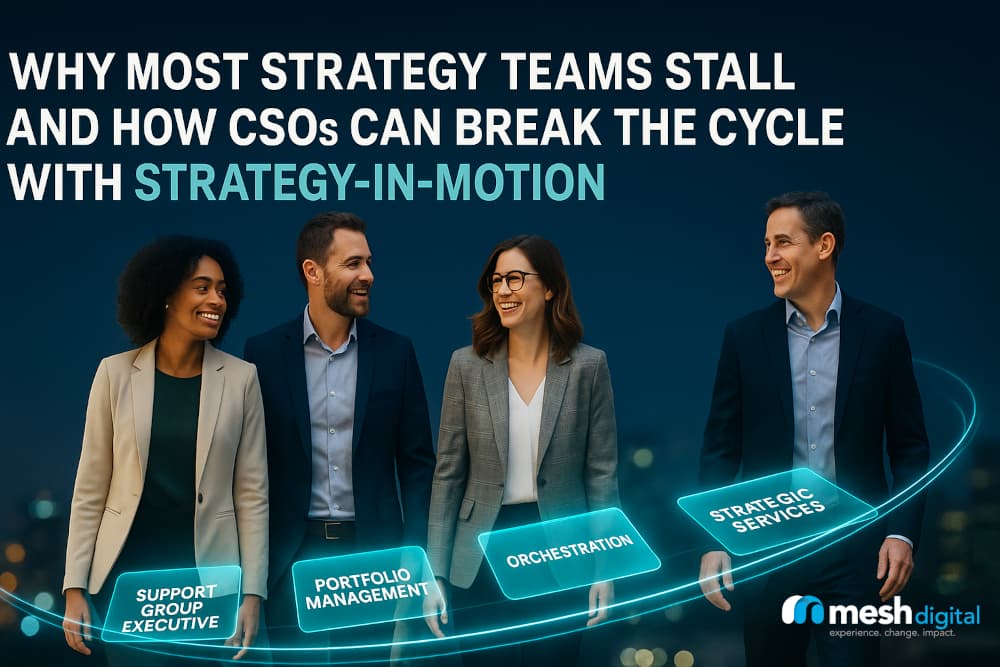Why Most Strategy Teams Stall and How CSOs Can Break the Cycle with Strategy-in-Motion
Strategy-in-Motion PODs™ help CSOs unify board support, portfolio management, orchestration, and strategic services transforming strategy from a static function into a high-performing, execution-ready system that delivers measurable value in one cohesive motion.

In today’s boardrooms, Chief Strategy Officers (CSOs) are under immense pressure. They must not only help CEOs shape the future but also ensure that strategy cascades through the organization in a way that business units can execute without friction. Yet, many CSOs find themselves caught between an executive board that wants clarity, business units that demand guidance, and strategy teams that struggle to balance competing mandates.
The hard truth? A significant share of executives are dissatisfied with their strategy organizations. Some CSOs even admit their own teams are not delivering the intended impact. The root cause isn’t usually a lack of talent or effort; it’s often structural. Many strategy functions attempt to be everything at once; CEO advisor, portfolio manager, orchestrator, and service provider. This “all-of-the-above” approach dilutes focus and lowers performance.
Mesh Digital’s Strategy-in-Motion PODs™ were designed to help strategy leaders break out of this trap. By structuring strategy delivery into adaptive, cross-functional PODs, staffed by a small number of senior resources. Organizations can reimagine how they support the executive board, manage the portfolio, orchestrate decisions, and deliver strategic services, all in a single, accountable motion.
Four Mandates, One Cohesive System
Most strategy teams anchor their work around one of four mandates:
- Group Executive Support. Acting as the CEO’s extended office, shaping corporate strategy, and setting targets.
- Portfolio Management. Systematically evaluating and shaping the business portfolio through disciplined capital allocation.
- Strategy Orchestration. Facilitating decision-making and aligning stakeholders on direction and trade-offs.
- Strategic Services. Delivering insights, competitive intelligence, and targeted support to business units.
Each mandate adds value. The problem arises when teams chase all four simultaneously without a unifying model. Harvard Business Review research shows, that when leaders, including those in strategy organizations who master focus are rated in the top quartile for overall effectiveness. For strategy teams, this means a clear, governed mandate is the foundation for success, while juggling competing priorities causes "goal dilution," a state that erodes both performance and team morale.
Strategy-in-Motion PODs™ address this by integrating mandates through modular design. Rather than forcing one central team to “do it all,” PODs are assembled with the right mix of strategic, financial, and operational expertise to address the mandate at hand. While still linking back to a single path of execution. They can be an extension of your team, used as a force multiplier, or even to help directly with line of business strategy, while the internal team drives it at the corporate level. More on this below.
Governance That Unlocks, Not Restricts
Governance may sound bureaucratic, but in high-performing strategy teams, it is the key differentiator. Too often, strategy governance is undefined, leaving CSOs to navigate fuzzy reporting lines or unclear relationships with business leaders.
Mesh Digital emphasizes “Single-Path Execution,” where the CSO, CEO, and board are aligned on mandate, governance, and reporting lines from the start.
Within a POD, this translates into three practices:
- Clear accountability: Each POD reports back to the CSO with a defined link to board-level priorities.
- Hybrid resourcing: Around 60–80% of resources can sit centrally within the POD, while the remainder embed directly into business units. This creates both consistency and frontline credibility.
- Adaptive steering: Governance isn’t rigid; PODs flex as new mandates emerge, such as a capital reallocation or an unexpected regulatory change.
The result is an organization that avoids the “push vs. pull” debate, where strategy teams either impose their work on business units or sit idle waiting for requests. Instead, PODs operate on a collaborative contract with stakeholders: engaged early, scoped clearly, and measured by value delivered.
Collaboration as the Core Muscle
No matter how elegant the mandate or governance, strategy fails without collaboration. The strategy function has two clients: the executive board and the business units. Yet in many companies, fewer than a quarter of strategy teams are seen as true collaborators by the businesses they serve.
Strategy-in-Motion PODs™ build collaboration into the operating model itself.
Here’s how:
- Dual-Client Orientation: Every POD is accountable to both the executive board and the business unit it supports.
- Embedded Workflows: POD members don’t just hand over PowerPoint decks; they co-create solutions alongside P&L owners.
- Feedback Loops: PODs include “telemetry”mechanisms to measure adoption, business impact, and stakeholder satisfaction in real time.
This approach reframes the CSO from “chief planner” to “chief collaborator,” ensuring that strategy is owned, not outsourced, by business leaders.
Beyond Planning: Value-Oriented Skills
High-performing strategy organizations differentiate themselves not by size or diversity of skillsets, but by their ability to bring value-oriented expertise into the room. Finance, M&A, and capital allocation often matter more than generic project management or digital skills.
Strategy-in-Motion PODs™ are built around this principle.
Each POD blends:
- Strategic Insight: Market and competitive intelligence.
- Financial Rigor: M&A, capital choreography, and resource allocation models.
- Execution Enablement: Operating model design, AI-assisted analytics, and regulatory compliance expertise.
This triad ensures that strategy isn’t just intellectually compelling but also financially viable and operationally executable.
The CEO-CSO Compact
Ultimately, the effectiveness of any strategy organization depends on the alignment between the CEO and CSO. If that relationship is fractured, no POD structure can fix it. Strategy-in-Motion PODs™ formalize this compact by creating a direct line of sight between CEO (and Board) priorities and POD deliverables.
For example:
- If the CEO needs higher-quality strategy, PODs sharpen the portfolio lens.
- If the company seeks innovation impulses, PODs integrate digital and ecosystem partners.
- If execution discipline is the gap, PODs reinforce governance and performance telemetry.
In every case, PODs provide the connective tissue between aspiration and action between board slides and shipped outcomes.
Why This Matters for CSOs
For Chief Strategy Officers, adopting a Strategy-in-Motion PODs™ model is not about outsourcing accountability or ballooning team size. It’s about re-architecting the way strategy is delivered:
- Support the Executive Board: PODs translate board-level ambition into tangible initiatives.
- Manage the Portfolio: PODs create transparent rules for where capital and talent should flow.
- Orchestrate Decisions: PODs build the collaborative forums where trade-offs are made, not avoided.
- Provide Strategic Services: PODs deliver targeted insights to business units, ensuring frontline leaders feel supported, not sidelined.
When these elements are combined into a single, integrated model, strategy stops being episodic and becomes continuous.
Closing Thoughts: Strategy-in-Motion as a Competitive Advantage
The modern CSO role is shifting from “keeper of the plan” to “orchestrator of motion.” Strategy-in-Motion PODs™ embody this evolution. They are not another layer of consulting or another siloed team; they are the mechanism by which strategy, delivery, and capital move in one motion.
For organizations seeking to close the gap between boardroom intent and frontline execution, this model provides a way forward. Not as a silver bullet, but as a pragmatic architecture that ensures strategy is not only formulated but also lived.
In a world where more than half of executives say they are unsatisfied with their strategy organizations, adopting a POD model may be the most effective move a CSO can make. Not just to satisfy the CEO, but to build a strategy function that is finally worthy of the term “high-performing.”
